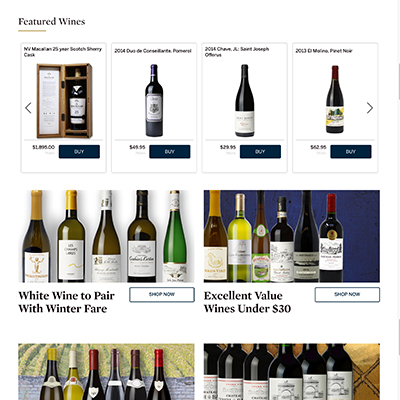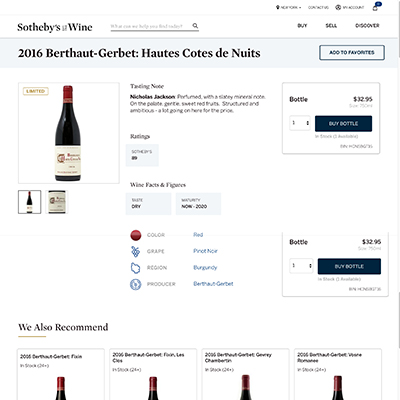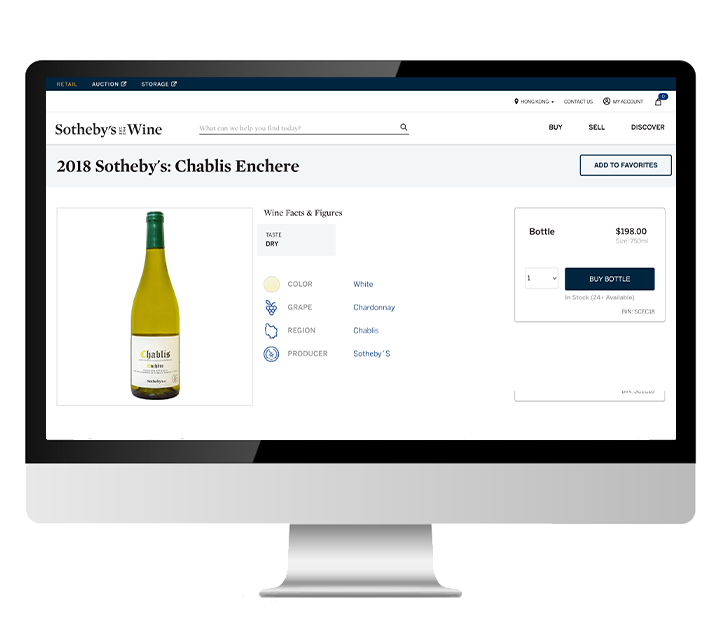Sotheby’s Wines
Multichannel international digital storefronts with integrated point-of-sale and subscription membership
At a Glance – Project Highlights
- Ultra replaced the Sotheby’s Wine’ legacy system with the Ultra platform for increased eCommerce functionality and security
- Project featured partnerships with Star Micronics and Datacap for all-in-one POS receipt printing and cloud-based POS payment solutions, respectively
- Work involved front-to-back re-platforming of the entire Sotheby’s Wines business, including a public-facing website
- Ultra eCommerce solution satisfies all protocols for PCI compliance, including GDPR, PA-DSS, and PCI DSS
From a business operations perspective, we’re in a much better place than we were a year ago. We’ve seen big improvements in our ability to manage inventory, orders, and customer relationships – especially with our repeat customers.
Time To Migrate
Think of Sotheby’s, and certain things immediately come to mind: auctions, art, antiques, jewelry, real estate, and fine wine, just to name a few. This multibillion-dollar organization has a long and distinguished history that stretches all the way back to 1744 – hundreds of years before the existence of the Internet. Moving this venerable company into the digital age was a serious undertaking, Sotheby’s Wine knew that it had some much-needed room for improvement with its eCommerce business.
Specifically, the wine business – both auction and retail – was sitting on an antiquated system. Although some eCommerce capabilities existed, the site was not responsive for mobile devices. But that wasn’t the only issue. Much of the behind-the-scenes work was still being done on paper. For instance, Sotheby’s Wine employees were still working with hard copies of invoices and printing out emails. And customers were required to mail in checks as payments for their purchases.
There was also the problem of storing customer IDs. Because the legacy system didn’t have the capability to house that kind of information online, clients had to fax copies of their driver’s licenses to Sotheby’s Wine. It wasn’t an optimal situation by any stretch of the imagination. The only real answer? Move everything into the digital space. With that realization, the search for a better solution began.
While a number of internal personnel had worked with Ultra previously, Sotheby’s Wine needed to perform due diligence in its search for an eCommerce solution. The company met with several potential eCommerce partners, sat through many demos, conducted interviews, and had in-depth conversations with different candidates. In the end, Ultra was selected because Sotheby’s Wine felt the Ultra platform did the best job of addressing Sotheby’s needs. It also helped that Ultra had a keen understanding of the wine world, as evidenced by the successful eCommerce work that Ultra had already done at Total Wine & More and the Adams Wine Group.
An ambitious project

From the beginning, it was clear that this would be a substantial project. “We would basically be re-platforming the operations of the entire Sotheby’s Wine business from front to back, including a public-facing website,” says Dave Crouch, COO of Ultra Commerce. As a result, Ultra would be handling everything: point of sales (POS), back office, shipping, warehousing, fulfillment, inventory, and the sothebyswine.com website. The project would require importing and mapping all of the Sotheby’s Wine legacy data – all orders, accounts, products, and more – from the existing system into Ultra. In addition, Ultra would set up an integration with the CyberSource® credit card payment processing platform.
The first order of business was working with the Sotheby’s Wine team on wireframes. It was important that everyone involved understand what the user experience would be and what the architecture would look like. Once the wireframes were complete, the Sotheby’s internal design team built the templates for the sothebyswine.com website. Ultra then took the design team’s templates and implemented them into Ultra.
Unique challenges
As Sumit Verma, CTO at Ultra Commerce, explains, there were some special factors with the implementation. The first was building a single, unified customer experience. “The Sotheby’s Wine business has both retail and auction arms in different parts of the world,” he says. “The retail side has operations in New York and Hong Kong, while the auction side has locations in New York, Hong Kong, and London. None of that, however, should matter to the customers who are visiting the sothebyswine.com website. The experience and the look needed to be the same, no matter what country people are logging in from.”
In the wine world, New York, Hong Kong, and London are all governed by different laws that require very specific ways of handling everything from inventory management to shipping and payment processing. With all the restrictions and differentiation in a given market, the process of creating and managing products for different markets can require a significant investment. Instead, Ultra was able to utilize the flexibility in the Ultra product management system to ensure that even though the product mix would be different by market, each item would carry the same SKU number and marketing characteristics. As a result, the Sotheby’s team can provide a unique product offering per market, and manage the offering as efficiently as possible.
In New York and Hong Kong, where Sotheby’s Wine has retail stores, there had to be availability in the front end at checkout to allow for various shipping and pickup options. That’s because wine shipping laws in the United States differ between states – strict government regulations dictate where Sotheby’s can ship wine. As a result, Ultra had to build solutions for Sotheby’s that took these laws into account and enabled shipping for only those states where it was allowed.
Where in-store pickup is an option, Ultra needed to consider the complexities of warehousing and inventory management, whether that wine is sitting in a warehouse in New Jersey or a building in Hong Kong. The Ultra platform ensures that inventory moves in a timely manner between the warehouse and the pickup location – wherever in the world those happen to be.
An elegant and robust solution
Although the wine business was the first in the Sotheby’s family to harness the power of Ultra, Sotheby’s recognized early on that there were exciting possibilities for the rest of the organization.
The POS system that Ultra built into Ultra offers significantly more advantages and capabilities to Sotheby’s Wine than its legacy system did. For instance, Ultra partnered with Star Micronics for all-in-one POS receipt printing that’s integrated with an iPad. The Ultra team also collaborated with Datacap, a company that provides cloud-based payment solutions for POS software like Ultra. As Verma says, the goal with these partnerships was to deliver an exceptional card reader experience, for magnetic “chip and pin” cards as well as wireless-enabled card readers. “It all ties in directly with the elegant aesthetic of Sotheby’s,” he explains. “The result is a state-of-the-art POS system that looks great on the store counter while reflecting the client’s corporate branding.”
In addition to supporting multiple languages, currencies, and payment methods, as well as the intricacies of government regulations, the Sotheby’s Wine Ultra platform offers unparalleled security and full PCI compliance. Overall security certification was something that was critically important and the Ultra platform satisfies all the protocols for PCI compliance, including GDPR (General Data Protection Regulation), PA-DSS (Payment Application Data Security Standard, and PCI DSS (Payment Card Industry Data Security Standard). These protocols ensured that going forward, Sotheby’s Wine would have a safe and paperless way to store customers’ credit card information – something it couldn’t do at all with its old system.
Just nine months after the implementation began – the Sotheby’s Wine website went live. As Crouch notes, “This project had an extremely aggressive timeline, given the scope of the work involved. We delivered on time, which was a testament to the hard work of everyone involved.”
Sotheby’s Wine immediately began reaping the benefits of the work that Ultra did. From a business operations perspective, it was now in a much better place than it was before the implementation began. The company has experienced significant improvements in its ability to manage inventory, orders, and customer relationships – especially with its repeat customers. Furthermore, the new Ultra platform has enabled Sotheby’s Wine to be more stringent with how customer and retail data is managed. For example, when users at Sotheby’s Wine want to create an order, they now need to capture both an email and a physical mailing address. The company has also seen an increase in business since its new platform has been up and running.
Adding value with enhancements
The Sotheby’s Wine team then began working with Ultra to plan a first phase of enhancements that would follow the initial Ultra rollout. Items on the wish list included a “one auction, one invoice” capability – meaning that winners of an auction would receive just one single invoice, no matter how many different lots of wine they’ve won. Other enhancement possibilities included supporting Automated Clearing House (electronic check) payments, improving the shipping process, addressing insurance concerns, and expanding service and business opportunities.
Izabela Baldyga, client solutions manager at Ultra, explains that work was already underway with several enhancements. “One of the first things we tackled was improving shipping,” she says. “We knew that we could help improve accuracy and add value for Sotheby’s Wine customers.”
As a result of the new business driven by the refreshed online store, the team quickly recognized that there was an opportunity to optimize the shipping system to reduce per package costs.

In the world of fine wine, “bottle” is not always a standard 750ml size. Some bottles are much, much larger than that. In addition, a single order for one customer might well consist of several boxes – not just one. And depending on the size of the bottles purchased, the sizes of the boxes might vary, too. To streamline things and prevent orders from being stranded, Ultra had to nail down the specifics of everything involved.
The Ultra worked with multiple teams at Sotheby’s to review all the various combinations of wine bottles and order combinations and determine what the best course of action would be to improve shipping efficiency and get more accurate costs. The engineering to determine those options would require running through a very similar process as was run at the beginning of the development process.
Case logic to the rescue
With the end result of the engineering process in hand, Ultra then needed to implement case logic that would send exact specifications on the items in each wine order to the shipping carrier. Updating the format and configuration sent to the carrier ensured accurate shipping rates, no matter how many bottles were in each order. All of this data-crunching and transmission would be invisible to Sotheby’s Wine customers, who simply needed the ability to purchase their wine, select a shipping option, and make it through checkout while knowing exactly what their shipping costs would be – regardless of how many boxes were involved.
The same calculation is re-used during the fulfillment process. The Sotheby’s Wine team member who generates shipping labels doesn’t need to know or look up the particulars of each order – the system pre-fills this information, which streamlines label creation.
The case logic implementation also included another benefit. As Baldyga notes, “When you’re dealing with rare and fine wines, it’s essential to have proper insurance in place, so your customers’ purchases are protected in the event of breakage.” But just having that insurance isn’t enough. Let’s say your customer’s order consists of three boxes. Two of them arrive in perfect condition, but one is damaged during shipping. To submit your insurance claim, you need to know the dollar value of the wines in that damaged box, and that means knowing exactly which wines went into which boxes during fulfillment and shipping. This becomes even more critical when you take into account that the values of collectible wines can vary wildly.
More enhancements, more opportunities
Shortly later, the Sotheby’s Wine case logic and shipping enhancements were live. Ultra then worked with the Sotheby’s mobile app developers to create a service for auction invoice payments. The result is that users who purchase goods at auction can now pay for their invoices via the Sotheby’s mobile app, with Ultra facilitating the payment transaction.
Ultra is even helping Sotheby’s expand the retail sales of its luxury goods. In 2018, Ultra worked on a successful proof of concept for the retail sale of diamonds using the Ultra API. Launched late in 2018, this proof of concept paves the way for Sotheby’s to eventually make other retail goods available on the marketplace with Ultra.
Looking ahead
Although the wine business was the first in the Sotheby’s family to harness the power of Ultra, Sotheby’s recognized early on that there were exciting possibilities for the rest of the organization – and that’s where yet another enhancement comes in.
“Sotheby’s has the overarching goal of unifying the experience for users who interact with the various websites that are under the Sotheby’s brand,” says Baldyga. “So, a customer who buys fine art at the Sotheby’s art website might also be interested in seeing what’s available at the Sotheby’s Wine website. The overall experience should be cohesive for the user and have the same Sotheby’s ‘feel’ across the different sites.”
That experience will add even more value – to Sotheby’s and its customers – if it capitalizes on the broad array of cross-searching and cross-selling opportunities that naturally exist throughout the various Sotheby’s businesses. To that end, Ultra is using a third-party tool to help turn opportunities into realities. The tool, Algolia, is a powerful search-as-a-service platform that improves and extends the way search results are rendered for the user.
Crouch notes that the philosophy of continuous improvement and enhancement isn’t isolated to the Sotheby’s Wine project – it’s central to the way Ultra does business and is one of Ultra’s greatest strengths. “Ultra is constantly enhancing the base code and functionality of the Ultra platform,” he explains. “Much of that work is the direct result of requests from our clients. But the great thing is that those improvements then get passed along to everyone. So each time there’s a new Ultra release, all clients ultimately benefit. That’s how you get much better-customized software. Everyone wins.”
Resource Center

A new blog series about the critical eCommerce capabilities missing in most eCommerce platforms for B2B companies. #1: Quoting & Sales Support

A closer look from the Ultra perspective on what we really mean when we talk about headless commerce and why it may not be right for every company.

Davis Art is now the only online K-12 publisher dedicated to the arts, creating top-notch curriculum and resources for art educators nationwide, all from the Ultra Commerce platform.



